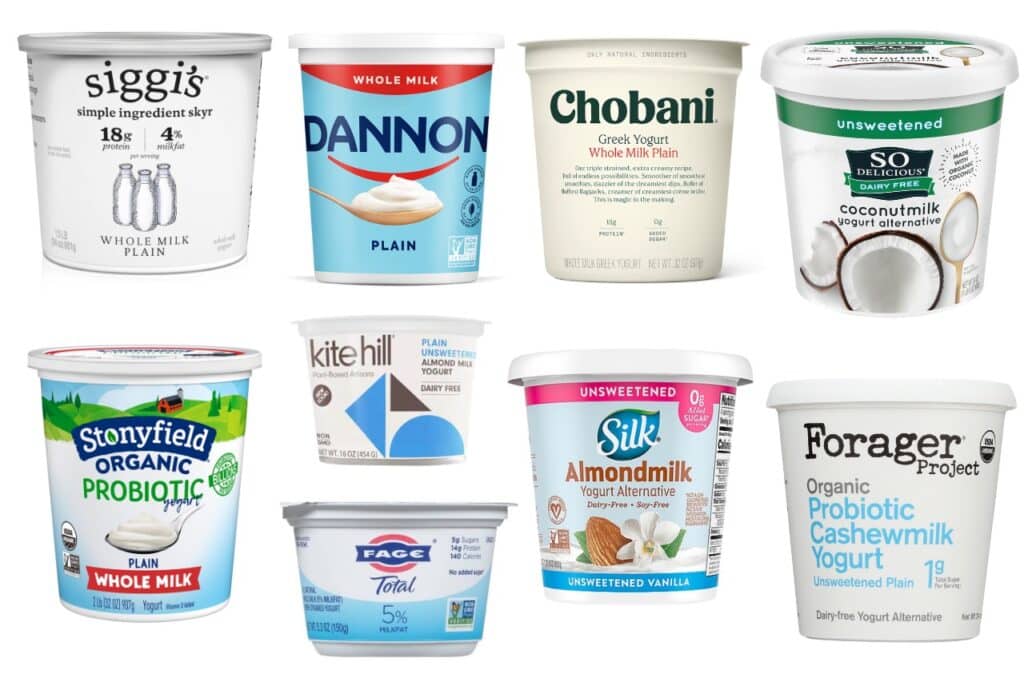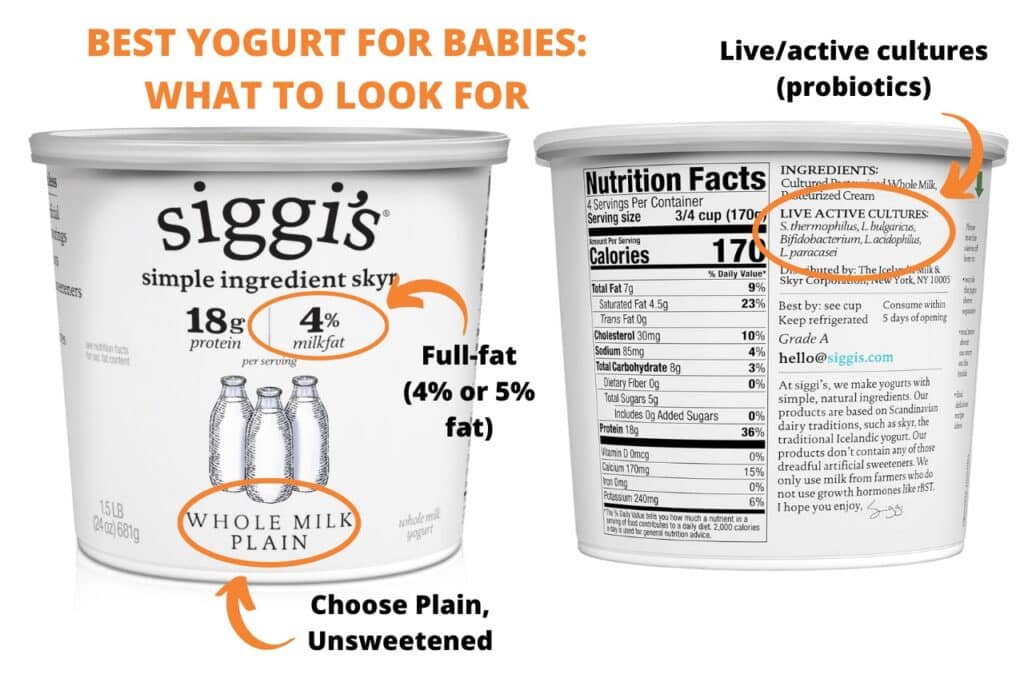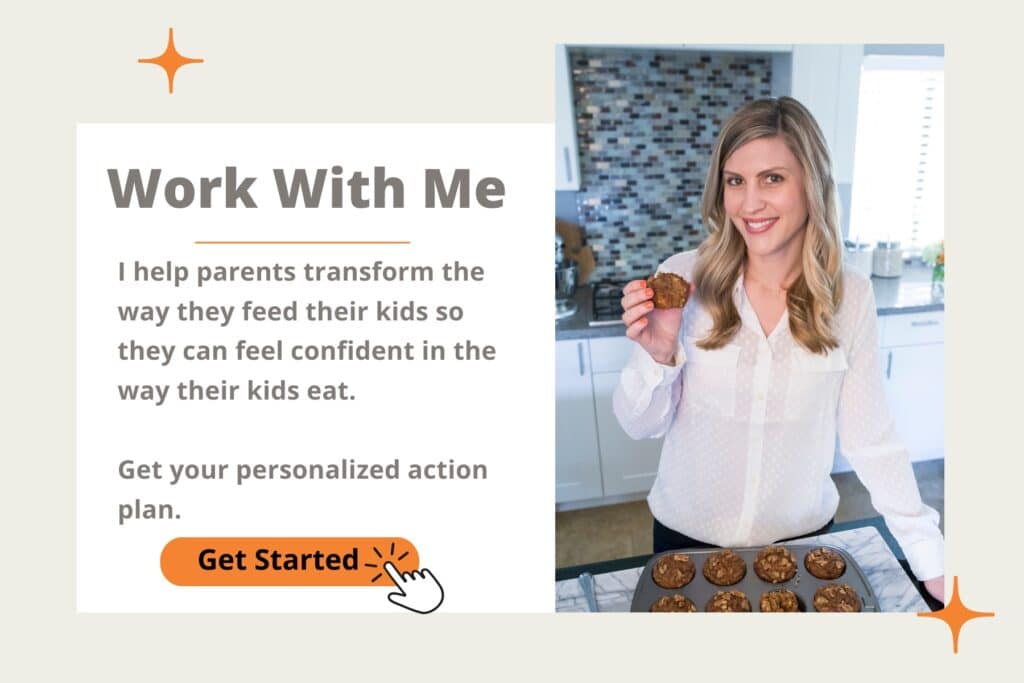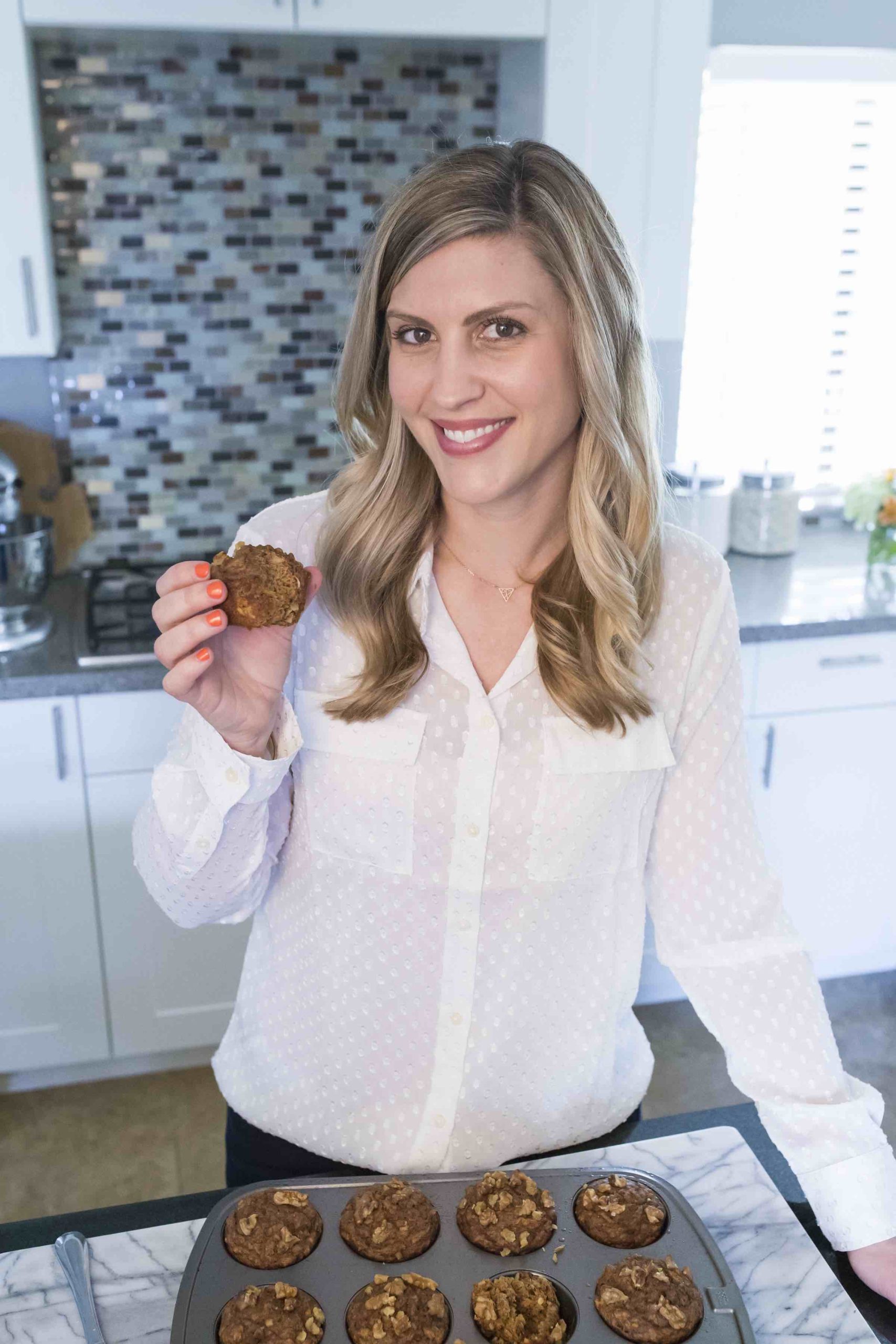When you’re getting ready to start your baby on solids, there are so many things to think about. I remember my first time starting solids with my oldest like it was yesterday, even with all my background as a pediatric dietitian, I was still nervous.
Introducing the top baby food allergens is one of the more nerve-wracking parts of the starting solids process for most parents. There are so many unknowns but also, a lot of inconsistent information floating around.
In this post, I want to talk about yogurt, one of the top allergens (dairy.) I’ll cover what is the best yogurt for babies when first starting solids (between 6 months and 1 year), and what yogurt to avoid, regardless of your feeding method, baby-led weaning or traditional weaning.
If you’re feeling stuck as to where to start with the introducing solids process, be sure to check out my comprehensive e-guide: Baby’s First Bites, which will walk you step by step through the entire starting solids process including: what to serve, key nutrients to focus on, what to avoid and even some sample menus and recipe ideas.

Please note that I am an affiliate for some of the linked products. If you click my affiliate link and make a purchase, I may earn a percentage of the sale at no extra cost to you. As an Amazon Associate, I earn from qualifying purchases.
Table of Contents
When can babies eat yogurt?
Babies can typically start eating yogurt as soon as they start the process of eating solids (around 6 months of age) when their signs of readiness for eating are present. Like many other developmental milestones, starting solids should occur based on your baby’s readiness. This is going to be different for every baby, so the 6-month mark is just a general guide.
Some babies are going to be ready sooner, maybe closer to the 5-5 ½ month range, and others later, especially babies who were born prematurely. For premature babies, developmental milestones are typically calculated based on their adjusted age, or the age they “would have” been born had they gone full term.
If you’re just getting ready to start solids and feel lost about what foods to introduce, my foods before one year checklist might come in handy! I used this with my own kids during the first 6 months of solids to keep track of new foods we’ve tried. I loved looking back on all the things we introduced.
Introducing allergens to baby
The newest guidelines based on current research for introducing allergens to babies includes early and frequent introduction of the top baby food allergens. These include dairy (yogurt falls in this category), finned fish, shellfish, peanuts, tree nuts, soy, wheat, eggs, and sesame. This means introduction should begin as early as safely possible (between 4-6 months) and by 12 months at the latest.
The National Institute of Allergy and Infectious Diseases has some guidelines for parents to help determine where their baby falls within the risk range for developing a reaction to common allergenic foods. I reviewed those guidelines in my post: baby food allergens-when and how to introduce them, if you want more details on all the top allergens and introducing them.
Introducing yogurt to baby
Yogurt (dairy) is a top baby food allergen. So, while it can be introduced shortly after starting solids, you do want to be mindful to watch out for any potential allergy reactions.
I typically recommend parents introduce non-common allergenic foods for their first week of starting solids and then slowly add in each of the top allergens one at a time after the first week or two. Waiting a few days between allergenic foods is important and can help you better determine what might have caused a reaction if one occurs.
Why can babies have yogurt but not milk?
This is a common question that I get from parents and there are several reasons for it.
- Yogurt is fermented so it is easier for your baby to digest than cow milk
- Dairy food (like yogurt, cheese, cottage cheese, etc.) are considered complementary foods, whereas milk would be considered more of a beverage. You don’t want to introduce any beverages (which take up a lot of space in the belly) potentially displacing the nutrients from breast milk or formula until after age one.
- Babies can’t have cow milk as a beverage because it is high in calcium which competes with iron for absorption. Too much cow milk (as a beverage) can cause babies to develop anemia. However, you can give your baby cow milk as part of a recipe ingredient, small amounts as part of a meal will not harm your baby.
Best yogurt for babies (6 months)
The best yogurt for babies when first starting solids is plain (full fat/whole milk) yogurt (regular or Greek), without added sugars or other flavors.
I recommend plain (full-fat) yogurt (regular or Greek) for the first yogurt introduction for a few reasons:
- Plain yogurt doesn’t contain added sugar (only the sugar naturally occurring in dairy)
- Full-fat yogurt provides extra fat (for their developing brains)
- It allows the baby to taste pure yogurt, before adding additional flavors
- The smooth consistency of plain yogurt gives them practice with that specific texture
Once you’ve given your baby plain yogurt, you can move on to adding mix-ins to the plain yogurt you have. This will give them additional exposure to various flavors and textures.

Baby yogurt mix-ins
After you’ve exposed your baby to plain yogurt, it becomes a great vehicle for additional flavors and textures.
These are some of my favorite ways to change up yogurt for babies:
- Pureed fruit
- Fresh minced/chopped fruit
- Frozen (defrosted) wild blueberries
- Spices: cinnamon, nutmeg, turmeric (caution these may cause skin irritation)
- Crushed unsweetened cereal (like O’s)
- Peanut butter (also a top allergen so introduce it separately first)
- Cooked cereal, oatmeal, or cream of wheat
Whole milk yogurt for babies
Parents often will ask why I am so adamant about them getting whole milk yogurt for their baby when they already have fat-free or low fat at home for themselves. The reason for this is pretty basic, babies need a lot of fat for their growth and development.
Up until age two, you don’t want to be restricting fat intake at all in your baby. Since they don’t eat large portions, you want to provide foods that give the most bang for your buck. Providing full-fat dairy sources is one way to do that.
If your family doesn’t do dairy, they can still meet their fat needs from other sources, however, if dairy is part of your family routine stick with the whole milk version until at least 2 years.
Dairy-free yogurt for babies
If you follow a vegetarian or vegan lifestyle and don’t do dairy in your family, there are still other options for yogurt. One thing to keep in mind is that many of the dairy-free yogurts on the market tend to contain added sugar. Be sure to grab one without added sugars for your baby.
Some dairy-free yogurts also contain less fat and protein than whole milk yogurts and are not always fortified with vitamin D, so be sure to read the labels. Many of these things can be made up for elsewhere in your baby’s diet, through food or supplements (like vitamin D), but it’s good to be mindful of this.
Top 5 dairy-free yogurt for babies (no added sugar)
- Silk unsweetened vanilla almond milk yogurt (contains active cultures, and vitamin D fortified, 6 g protein)
- Forager unsweetened plain cashew milk yogurt (contains active cultures, but NOT vitamin D fortified, 3 g protein)
- Kite Hill unsweetened plain Greek style, almond milk yogurt (contains active cultures, but NOT vitamin D fortified, 17 g protein)
- Lava original plant-based yogurt, no added sugar (contains active cultures, but NOT vitamin D fortified, 2 g protein)
- So Delicious unsweetened vanilla coconut milk yogurt ( contains active cultures, vitamin D fortified, <1g protein)
Baby yogurt vs. regular yogurt
You might be tempted to go out and grab all the cute baby food packages you see when you’re at the store. I get it, they’re often very enticing! Unfortunately, baby yogurt is just an overpriced version of regular yogurt that has great marketing.
The primary benefits of baby yogurt vs. regular yogurt are the small convenient packaging and portion size. Some baby yogurts may also contain blends of other things like fruit or cereal which may change the nutrient composition (lower the protein per serving). While it is nice to have some protein in yogurt, your baby doesn’t need high volumes of protein, so baby yogurts help with that.
I never bought any “baby” yogurt for my kids, I found it much easier and more cost-effective to purchase regular, plain unsweetened yogurt, watch how much I was serving, and then create my own mix-ins to lower the protein per serving. I reviewed some of my favorite baby yogurt mix-ins above.
Benefits of yogurt for babies
Yogurt has many benefits for babies (and beyond) with one of the biggest benefits being its probiotics. Yogurt is one of the best probiotic foods for kids (including babies) because it is easy to consume, well-accepted and relatively cost-effective.
When looking for a yogurt for your baby, look for one that contains live cultures, which will be clearly stated on the package.

In addition to probiotics, full fat plain yogurt provides a good source of fat for your baby’s developing brain as well as protein, calcium and vitamin D for their rapidly growing body.
Probiotic yogurt for babies (top 5)
These are my favorite probiotic rich yogurts to serve to babies that are also unsweetened (no added sugar) and full fat! These are all pretty easy to find brands in most grocery stores.
- Siggis whole milk plain skyr yogurt (contains: S. thermophilus, L. delbrueckii subsp. bulgaricus, B. lactis, L. acidophilus, L. delbrueckii subsp. lactis)
- Chobani whole milk plain yogurt (contains: S. Thermophilus, L. Bulgaricus, L. Acidophilus, Bifidus, L. Casei, and L. Rhamnosus)
- Fage Total (5%) plain whole milk greek yogurt (contains: L. Bulgaricus, S. Thermophilus, L. Acidophilus, Bifidus, L. Casei)
- Stonyfield Organic probiotic plain whole milk yogurt (Contains: S. thermophilus, L. bulgaricus, Bifidobacterium BB-12®, L. acidophilus, L. paracasei and L. rhamnosus.)
- Dannon whole milk plain (contains: S. Thermophilus, L. Bulgaricus & L. Acidophilus)
Yogurt drops for babies
I couldn’t write this post on yogurt for babies without addressing yogurt drops. These might be the most popular things I see babies eating when out and about. However, the yogurt drops “melts” most people are thinking of are not actually yogurt at all.
While many of the melts contain milk, they also contain added sugar, and starch along with some fruit. Below is a label with the ingredients from one of the more popular yogurt melt brands. As you can see the second ingredient in the product is sugar (weighed by volume), something we generally try to avoid when possible for babies.

While these are great for keeping babies entertained, they provide very little nutritional value and mostly just add unnecessary sugar to their diet. If you’re looking for an easy snack to keep your baby entertained while you are out, simple unsweetened O’s cereal would be a much better, cost effective and more nutritious choice.
You could also try the Amara smoothie melts, which contain no added sugar and are a better alternative to most of the yogurt melt brands.
Homemade yogurt drops for babies
If you really like the idea of yogurt drops, you can make your own at home. Blend plain yogurt (the best yogurt for babies) and fruit in a food processor and then drop tiny drops onto a parchment lined cookie sheet and freeze overnight. When you pull them out, break off the little buttons and store them in a container in the freezer.
These are great for babies who are able to use their pincer grasp (pick up with their finger and thumb), but they do melt quick so they need to be eaten at home.
Best yogurt for toddlers and kids
Hitting the 1 year mark is a huge milestone. When you get to age one you usually feel a lot more confident in their eating. While one year olds tend to be able to handle a larger variety of food than babies around the 6 month mark, the yogurt they eat should be essentially the same.
Overall, I recommend limiting added sugar (including added sugars in yogurt) until after your child hits the 2 year mark. Even then, we want to keep added sugars as minimal as possible.
However, you might notice some picky eating tendencies start to kick in, including refusing foods (like plain yogurt) that they previously ate very well. If your toddler won’t eat, you might feel frustrated. This might tempt you to start reaching for some of the more “kid” focused yogurt packaging like yogurt tubes, and drinkable yogurt. While this is okay for kids over 2 in limited quantities, I would still recommend limiting added sugar in products to 6 g or less.
Here are 6 options I’ve found that are decent choices for kids & fit well in lunchboxes
- Earths Best “grow with us” yogurt (5 g protein, 4 g added sugar)
- Siggi’s yogurt pouches (5 g protein, 4 g added sugar)
- Stonyfield Organic fruit & veggie pouches (5 g protein, 4 g added sugar)
- Stonyfield Organic yogurt tubes (2 g protein 4 g added sugar)
- Stonyfield Organic drinkable yogurt (3 g protein, 6 g added sugar)
- Activa Probiotic Dailies (3 g protein, 6 g added sugar
Summary
Going through the process of starting solids with you baby can be both fun and overwhelming. Making the most informed food choices will help boost your confidence.
When it comes to introducing yogurt, the best yogurt for babies is going to be plain, full fat, unsweetened yogurt. This will provide the most nutrition, and prevent them from ingesting unnecessary added sugars.
Be sure to introduce yogurt separate from other allergenic foods so you can effectively monitor for a reaction. Always talk with your baby’s pediatrician if your feel they have a high risk for allergic reaction to foods.
There are many benefits to offering yogurt to your baby including probiotics, calcium, vitamin D and protein. Many yogurts have live and active cultures which can help promote a healthy gut.
Continue to provide your baby yogurt without added sugar until at least 2 years. From there, if you do provide more pre packaged flavored versions, keep added sugars under 6 g per serving.
If you need more help with feeding your baby, I can help. You can check out my comprehensive starting solids guide or book a 1:1 consult and I can walk you through the process step by step.


